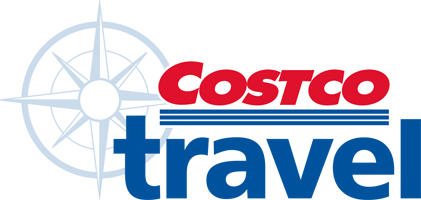
Caribbean and Bahamas: Eastern Caribbean Cruise
Carnival Cruise Line
We don't have proof, but evidence suggests that the Caribbean was made for cruising. This evidence is all around you — you'll find it in the Caribbean air, the sand and the water. And with more than 5,000 islands and cays spread across this amazing region, there's a lot of paradise to see.

Executive Member Benefit
Executive Members receive an annual 2% Reward, up to $1,250, on qualified Costco Travel purchases
Digital Costco Shop Card
Member Exclusive: Digital Costco Shop Card with every Carnival Cruise Line sailing†
Sailing Itinerary

Note: Cruise itineraries are subject to change. Please verify ports and times directly with the cruise line.
Overview
If the story of the founding of Fairbanks had happened anywhere else, it wouldn't be told so proudly, for the city's father was a swindler, and its undignified birth contained an element of chance not usually admitted in polite society. As the popular story goes (and the historians' version is fairly close), it seems that in 1901, E. T. Barnette decided to get rich by starting a gold-mining boomtown like the others that had sprouted from Dawson City to Nome as the stampeders of 1898 sloshed back and forth across the territory from one gold find to the next. He booked passage on a riverboat going up the Tanana with his supplies to build the town, having made an understanding with the captain that, should the vessel get stuck, he would lighten the load by getting off with the materials on the nearest bank. Unfortunately, the captain got lost. Thinking he was heading up a slough on the Tanana, he got sidetracked into the relatively small Chena River. That was where the boat got stuck and where Barnette got left, and that was where he founded Fairbanks. Fortunately for Barnette, an Italian prospector named Felix Pedro had been looking for gold in the hills around the new trading post, and made a strike on the Tanana. On that news, Barnette dispatched his Chinese cook-off to Dawson City to spread the word. The cook's story showed up in a newspaper that winter and a stampede of hundreds of miners ensued, heading toward Fairbanks in weather as cold as -50°F. Barnette's town was a success, but the cook nearly got lynched when the stampeders found out how far he'd exaggerated the truth. Much more gold was found later, however, and half the population of Dawson City came downriver to Fairbanks. Barnette had made it big. The town's future was assured thanks to a political deal. Barnette did a favor for the territory's judge, James Wickersham, by naming the settlement for Wickersham's ally in Congress, Sen. Charles Fairbanks of Indiana, who later became vice president. Wickersham then moved the federal courthouse to Fairbanks from Eagle--he loaded his records on his dogsled and mushed here, establishing the camp as the hub of the region. Wickersham's story is interesting, too. He was a notable explorer, Alaska's first real statesman as a nonvoting delegate to Congress, and the father of the Alaska Railroad. Houses he lived in are preserved at Alaska and in Fairbanks and Juneau just up the hill from the capitol building. Barnette didn't do as well in history's eyes: He was run out of the town he founded for bank fraud. Fairbanks is Alaska's second-largest city now, with a population of about 30,000 in the city limits and 82,000 in the greater metropolitan area, but it has never learned to put on airs. It sprawls, broad and flat, along big highways and the Chena. It's a friendly, easygoing town, but one where people still take gold and their independence seriously. They're still prospecting and mining for gold around here, fighting off environmental regulation, and maintaining a traditional Alaskan attitude that it's us against the world. Fairbanks is the birthplace of strange political movements, including the secessionist Alaskan Independence Party. It's an adamant, loopy, affable place; it doesn't seem to mind being a little bizarre or residing far from the center of things. And that makes it an intensely Alaska city, for those are the qualities Alaskans most cherish in their myth of themselves. Fairbanks can strike a visitor a couple of ways, depending on what you expect and what you like. Fairbanks can come across as a provincial outpost, a touristy cross between Kansas and Siberia. Driving one of the franchise-choked commercial strips, you can wonder why you went out of your way to come here, and the deserted downtown area can be downright depressing. Or you can relax and take Fairbanks on its terms, as a fun, unpretentious town that never lost its sense of being on the frontier. My children love it here. There's plenty for families to do in Fairbanks, much of it at least a little corny and requiring drives to widespread sites at the university, on the Chena River, in the gold mining area north of town, and at a big town park called Alaskaland. (You must have wheels in Fairbanks.) There are good opportunities for hiking and mountain biking and great opportunities for canoeing and slow river float trips.
Overview
If the story of the founding of Fairbanks had happened anywhere else, it wouldn't be told so proudly, for the city's father was a swindler, and its undignified birth contained an element of chance not usually admitted in polite society. As the popular story goes (and the historians' version is fairly close), it seems that in 1901, E. T. Barnette decided to get rich by starting a gold-mining boomtown like the others that had sprouted from Dawson City to Nome as the stampeders of 1898 sloshed back and forth across the territory from one gold find to the next. He booked passage on a riverboat going up the Tanana with his supplies to build the town, having made an understanding with the captain that, should the vessel get stuck, he would lighten the load by getting off with the materials on the nearest bank. Unfortunately, the captain got lost. Thinking he was heading up a slough on the Tanana, he got sidetracked into the relatively small Chena River. That was where the boat got stuck and where Barnette got left, and that was where he founded Fairbanks. Fortunately for Barnette, an Italian prospector named Felix Pedro had been looking for gold in the hills around the new trading post, and made a strike on the Tanana. On that news, Barnette dispatched his Chinese cook-off to Dawson City to spread the word. The cook's story showed up in a newspaper that winter and a stampede of hundreds of miners ensued, heading toward Fairbanks in weather as cold as -50°F. Barnette's town was a success, but the cook nearly got lynched when the stampeders found out how far he'd exaggerated the truth. Much more gold was found later, however, and half the population of Dawson City came downriver to Fairbanks. Barnette had made it big. The town's future was assured thanks to a political deal. Barnette did a favor for the territory's judge, James Wickersham, by naming the settlement for Wickersham's ally in Congress, Sen. Charles Fairbanks of Indiana, who later became vice president. Wickersham then moved the federal courthouse to Fairbanks from Eagle--he loaded his records on his dogsled and mushed here, establishing the camp as the hub of the region. Wickersham's story is interesting, too. He was a notable explorer, Alaska's first real statesman as a nonvoting delegate to Congress, and the father of the Alaska Railroad. Houses he lived in are preserved at Alaska and in Fairbanks and Juneau just up the hill from the capitol building. Barnette didn't do as well in history's eyes: He was run out of the town he founded for bank fraud. Fairbanks is Alaska's second-largest city now, with a population of about 30,000 in the city limits and 82,000 in the greater metropolitan area, but it has never learned to put on airs. It sprawls, broad and flat, along big highways and the Chena. It's a friendly, easygoing town, but one where people still take gold and their independence seriously. They're still prospecting and mining for gold around here, fighting off environmental regulation, and maintaining a traditional Alaskan attitude that it's us against the world. Fairbanks is the birthplace of strange political movements, including the secessionist Alaskan Independence Party. It's an adamant, loopy, affable place; it doesn't seem to mind being a little bizarre or residing far from the center of things. And that makes it an intensely Alaska city, for those are the qualities Alaskans most cherish in their myth of themselves. Fairbanks can strike a visitor a couple of ways, depending on what you expect and what you like. Fairbanks can come across as a provincial outpost, a touristy cross between Kansas and Siberia. Driving one of the franchise-choked commercial strips, you can wonder why you went out of your way to come here, and the deserted downtown area can be downright depressing. Or you can relax and take Fairbanks on its terms, as a fun, unpretentious town that never lost its sense of being on the frontier. My children love it here. There's plenty for families to do in Fairbanks, much of it at least a little corny and requiring drives to widespread sites at the university, on the Chena River, in the gold mining area north of town, and at a big town park called Alaskaland. (You must have wheels in Fairbanks.) There are good opportunities for hiking and mountain biking and great opportunities for canoeing and slow river float trips.
Overview
If the story of the founding of Fairbanks had happened anywhere else, it wouldn't be told so proudly, for the city's father was a swindler, and its undignified birth contained an element of chance not usually admitted in polite society. As the popular story goes (and the historians' version is fairly close), it seems that in 1901, E. T. Barnette decided to get rich by starting a gold-mining boomtown like the others that had sprouted from Dawson City to Nome as the stampeders of 1898 sloshed back and forth across the territory from one gold find to the next. He booked passage on a riverboat going up the Tanana with his supplies to build the town, having made an understanding with the captain that, should the vessel get stuck, he would lighten the load by getting off with the materials on the nearest bank. Unfortunately, the captain got lost. Thinking he was heading up a slough on the Tanana, he got sidetracked into the relatively small Chena River. That was where the boat got stuck and where Barnette got left, and that was where he founded Fairbanks. Fortunately for Barnette, an Italian prospector named Felix Pedro had been looking for gold in the hills around the new trading post, and made a strike on the Tanana. On that news, Barnette dispatched his Chinese cook-off to Dawson City to spread the word. The cook's story showed up in a newspaper that winter and a stampede of hundreds of miners ensued, heading toward Fairbanks in weather as cold as -50°F. Barnette's town was a success, but the cook nearly got lynched when the stampeders found out how far he'd exaggerated the truth. Much more gold was found later, however, and half the population of Dawson City came downriver to Fairbanks. Barnette had made it big. The town's future was assured thanks to a political deal. Barnette did a favor for the territory's judge, James Wickersham, by naming the settlement for Wickersham's ally in Congress, Sen. Charles Fairbanks of Indiana, who later became vice president. Wickersham then moved the federal courthouse to Fairbanks from Eagle--he loaded his records on his dogsled and mushed here, establishing the camp as the hub of the region. Wickersham's story is interesting, too. He was a notable explorer, Alaska's first real statesman as a nonvoting delegate to Congress, and the father of the Alaska Railroad. Houses he lived in are preserved at Alaska and in Fairbanks and Juneau just up the hill from the capitol building. Barnette didn't do as well in history's eyes: He was run out of the town he founded for bank fraud. Fairbanks is Alaska's second-largest city now, with a population of about 30,000 in the city limits and 82,000 in the greater metropolitan area, but it has never learned to put on airs. It sprawls, broad and flat, along big highways and the Chena. It's a friendly, easygoing town, but one where people still take gold and their independence seriously. They're still prospecting and mining for gold around here, fighting off environmental regulation, and maintaining a traditional Alaskan attitude that it's us against the world. Fairbanks is the birthplace of strange political movements, including the secessionist Alaskan Independence Party. It's an adamant, loopy, affable place; it doesn't seem to mind being a little bizarre or residing far from the center of things. And that makes it an intensely Alaska city, for those are the qualities Alaskans most cherish in their myth of themselves. Fairbanks can strike a visitor a couple of ways, depending on what you expect and what you like. Fairbanks can come across as a provincial outpost, a touristy cross between Kansas and Siberia. Driving one of the franchise-choked commercial strips, you can wonder why you went out of your way to come here, and the deserted downtown area can be downright depressing. Or you can relax and take Fairbanks on its terms, as a fun, unpretentious town that never lost its sense of being on the frontier. My children love it here. There's plenty for families to do in Fairbanks, much of it at least a little corny and requiring drives to widespread sites at the university, on the Chena River, in the gold mining area north of town, and at a big town park called Alaskaland. (You must have wheels in Fairbanks.) There are good opportunities for hiking and mountain biking and great opportunities for canoeing and slow river float trips.
Overview
If the story of the founding of Fairbanks had happened anywhere else, it wouldn't be told so proudly, for the city's father was a swindler, and its undignified birth contained an element of chance not usually admitted in polite society. As the popular story goes (and the historians' version is fairly close), it seems that in 1901, E. T. Barnette decided to get rich by starting a gold-mining boomtown like the others that had sprouted from Dawson City to Nome as the stampeders of 1898 sloshed back and forth across the territory from one gold find to the next. He booked passage on a riverboat going up the Tanana with his supplies to build the town, having made an understanding with the captain that, should the vessel get stuck, he would lighten the load by getting off with the materials on the nearest bank. Unfortunately, the captain got lost. Thinking he was heading up a slough on the Tanana, he got sidetracked into the relatively small Chena River. That was where the boat got stuck and where Barnette got left, and that was where he founded Fairbanks. Fortunately for Barnette, an Italian prospector named Felix Pedro had been looking for gold in the hills around the new trading post, and made a strike on the Tanana. On that news, Barnette dispatched his Chinese cook-off to Dawson City to spread the word. The cook's story showed up in a newspaper that winter and a stampede of hundreds of miners ensued, heading toward Fairbanks in weather as cold as -50°F. Barnette's town was a success, but the cook nearly got lynched when the stampeders found out how far he'd exaggerated the truth. Much more gold was found later, however, and half the population of Dawson City came downriver to Fairbanks. Barnette had made it big. The town's future was assured thanks to a political deal. Barnette did a favor for the territory's judge, James Wickersham, by naming the settlement for Wickersham's ally in Congress, Sen. Charles Fairbanks of Indiana, who later became vice president. Wickersham then moved the federal courthouse to Fairbanks from Eagle--he loaded his records on his dogsled and mushed here, establishing the camp as the hub of the region. Wickersham's story is interesting, too. He was a notable explorer, Alaska's first real statesman as a nonvoting delegate to Congress, and the father of the Alaska Railroad. Houses he lived in are preserved at Alaska and in Fairbanks and Juneau just up the hill from the capitol building. Barnette didn't do as well in history's eyes: He was run out of the town he founded for bank fraud. Fairbanks is Alaska's second-largest city now, with a population of about 30,000 in the city limits and 82,000 in the greater metropolitan area, but it has never learned to put on airs. It sprawls, broad and flat, along big highways and the Chena. It's a friendly, easygoing town, but one where people still take gold and their independence seriously. They're still prospecting and mining for gold around here, fighting off environmental regulation, and maintaining a traditional Alaskan attitude that it's us against the world. Fairbanks is the birthplace of strange political movements, including the secessionist Alaskan Independence Party. It's an adamant, loopy, affable place; it doesn't seem to mind being a little bizarre or residing far from the center of things. And that makes it an intensely Alaska city, for those are the qualities Alaskans most cherish in their myth of themselves. Fairbanks can strike a visitor a couple of ways, depending on what you expect and what you like. Fairbanks can come across as a provincial outpost, a touristy cross between Kansas and Siberia. Driving one of the franchise-choked commercial strips, you can wonder why you went out of your way to come here, and the deserted downtown area can be downright depressing. Or you can relax and take Fairbanks on its terms, as a fun, unpretentious town that never lost its sense of being on the frontier. My children love it here. There's plenty for families to do in Fairbanks, much of it at least a little corny and requiring drives to widespread sites at the university, on the Chena River, in the gold mining area north of town, and at a big town park called Alaskaland. (You must have wheels in Fairbanks.) There are good opportunities for hiking and mountain biking and great opportunities for canoeing and slow river float trips.
Overview
If the story of the founding of Fairbanks had happened anywhere else, it wouldn't be told so proudly, for the city's father was a swindler, and its undignified birth contained an element of chance not usually admitted in polite society. As the popular story goes (and the historians' version is fairly close), it seems that in 1901, E. T. Barnette decided to get rich by starting a gold-mining boomtown like the others that had sprouted from Dawson City to Nome as the stampeders of 1898 sloshed back and forth across the territory from one gold find to the next. He booked passage on a riverboat going up the Tanana with his supplies to build the town, having made an understanding with the captain that, should the vessel get stuck, he would lighten the load by getting off with the materials on the nearest bank. Unfortunately, the captain got lost. Thinking he was heading up a slough on the Tanana, he got sidetracked into the relatively small Chena River. That was where the boat got stuck and where Barnette got left, and that was where he founded Fairbanks. Fortunately for Barnette, an Italian prospector named Felix Pedro had been looking for gold in the hills around the new trading post, and made a strike on the Tanana. On that news, Barnette dispatched his Chinese cook-off to Dawson City to spread the word. The cook's story showed up in a newspaper that winter and a stampede of hundreds of miners ensued, heading toward Fairbanks in weather as cold as -50°F. Barnette's town was a success, but the cook nearly got lynched when the stampeders found out how far he'd exaggerated the truth. Much more gold was found later, however, and half the population of Dawson City came downriver to Fairbanks. Barnette had made it big. The town's future was assured thanks to a political deal. Barnette did a favor for the territory's judge, James Wickersham, by naming the settlement for Wickersham's ally in Congress, Sen. Charles Fairbanks of Indiana, who later became vice president. Wickersham then moved the federal courthouse to Fairbanks from Eagle--he loaded his records on his dogsled and mushed here, establishing the camp as the hub of the region. Wickersham's story is interesting, too. He was a notable explorer, Alaska's first real statesman as a nonvoting delegate to Congress, and the father of the Alaska Railroad. Houses he lived in are preserved at Alaska and in Fairbanks and Juneau just up the hill from the capitol building. Barnette didn't do as well in history's eyes: He was run out of the town he founded for bank fraud. Fairbanks is Alaska's second-largest city now, with a population of about 30,000 in the city limits and 82,000 in the greater metropolitan area, but it has never learned to put on airs. It sprawls, broad and flat, along big highways and the Chena. It's a friendly, easygoing town, but one where people still take gold and their independence seriously. They're still prospecting and mining for gold around here, fighting off environmental regulation, and maintaining a traditional Alaskan attitude that it's us against the world. Fairbanks is the birthplace of strange political movements, including the secessionist Alaskan Independence Party. It's an adamant, loopy, affable place; it doesn't seem to mind being a little bizarre or residing far from the center of things. And that makes it an intensely Alaska city, for those are the qualities Alaskans most cherish in their myth of themselves. Fairbanks can strike a visitor a couple of ways, depending on what you expect and what you like. Fairbanks can come across as a provincial outpost, a touristy cross between Kansas and Siberia. Driving one of the franchise-choked commercial strips, you can wonder why you went out of your way to come here, and the deserted downtown area can be downright depressing. Or you can relax and take Fairbanks on its terms, as a fun, unpretentious town that never lost its sense of being on the frontier. My children love it here. There's plenty for families to do in Fairbanks, much of it at least a little corny and requiring drives to widespread sites at the university, on the Chena River, in the gold mining area north of town, and at a big town park called Alaskaland. (You must have wheels in Fairbanks.) There are good opportunities for hiking and mountain biking and great opportunities for canoeing and slow river float trips.
Overview
Denali National Park and Preserve in Alaska is the very heart of the rugged Alaskan Interior. Denali National Park and Preserve is home to six million acres of wilderness. North America's highest mountain, Mt. McKinley. Glaciers and a sub-arctic ecosystem are found in Denali National Park and Preserve. An internationally designated bio-sphere preserve, Denali National Park and Preserve is home to abundant moose, caribou, Dall sheep, grizzly bears, and wolves Denali National Park and Preserve is a place with fascinating Native American culture and history. It is a place where hearty adventurers panned for gold and dog sleds, backpacks and mountaineering gear are common. Alaska is the place of the Midnight Sun. Denali National Park and Preserve is a place where you can live out your Alaska travel dreams, whether they be wild adventures or serene contemplations. Denali National Park and Preserve is a must-see part of your Alaskan vacation.
Overview
Denali National Park and Preserve in Alaska is the very heart of the rugged Alaskan Interior. Denali National Park and Preserve is home to six million acres of wilderness. North America's highest mountain, Mt. McKinley. Glaciers and a sub-arctic ecosystem are found in Denali National Park and Preserve. An internationally designated bio-sphere preserve, Denali National Park and Preserve is home to abundant moose, caribou, Dall sheep, grizzly bears, and wolves Denali National Park and Preserve is a place with fascinating Native American culture and history. It is a place where hearty adventurers panned for gold and dog sleds, backpacks and mountaineering gear are common. Alaska is the place of the Midnight Sun. Denali National Park and Preserve is a place where you can live out your Alaska travel dreams, whether they be wild adventures or serene contemplations. Denali National Park and Preserve is a must-see part of your Alaskan vacation.
Overview
Denali National Park and Preserve in Alaska is the very heart of the rugged Alaskan Interior. Denali National Park and Preserve is home to six million acres of wilderness. North America's highest mountain, Mt. McKinley. Glaciers and a sub-arctic ecosystem are found in Denali National Park and Preserve. An internationally designated bio-sphere preserve, Denali National Park and Preserve is home to abundant moose, caribou, Dall sheep, grizzly bears, and wolves Denali National Park and Preserve is a place with fascinating Native American culture and history. It is a place where hearty adventurers panned for gold and dog sleds, backpacks and mountaineering gear are common. Alaska is the place of the Midnight Sun. Denali National Park and Preserve is a place where you can live out your Alaska travel dreams, whether they be wild adventures or serene contemplations. Denali National Park and Preserve is a must-see part of your Alaskan vacation.
Overview
Amid the wild countryside that crowds around it on all sides, Anchorage has grown into a spirited, cosmopolitan city - by far Alaska's largest and most sophisticated. The relative affluence of its largely white-collar population - with a sprinkling of olive drab from nearby military bases - attracts fine restaurants and pricey shops, first-rate entertainment, and world-class sporting events. Flashy modern towers punctuate the skyline, and colorful flowers spill from hundreds of baskets on downtown lampposts. Traffic from the city's busy international airport, served by more than 15 international and domestic airlines, lends a more cosmopolitan air than you might expect from a city with only 258,000 residents - nearly half the people in the state. Yet despite the 14 McDonald's, 2 Wal-Marts, and a 16-plex movie theater, the city has not entirely lost touch with its frontier spirit. Sled dog races are still revered, and moose and bear sightings in downtown Anchorage or on the Coastal Trail that rims the water are not uncommon. First incorporated in 1920, Anchorage is still a young city. Its citizens' median age of 30 and aggressive style make this - and not the capital city of Juneau - the state's power center. In addition to acting as the state's oil development center, Anchorage hustles its living as a government, banking, transportation, and communications hub. Anchorage residents are primarily from elsewhere in America - they include oil workers from such conservative oil-patch states as Oklahoma and Texas - and the attitudes they bring have fueled the conservative, pro-development mentality that characterizes the city and Alaska as a whole. Although representing less than 8% of the population, Alaskan Native peoples add an important cultural dimension. A growing Asian population is also having an impact, with well-stocked Asian food stores and restaurants an increasingly familiar sight. Boom and bust periods followed major events: an influx of military bases during World War II; a massive buildup of Arctic missile-warning stations during the Cold War; reconstruction following the devastating Good Friday earthquake of 1964; and in the late 1960s the biggest bonanza of all - the discovery of oil at Prudhoe Bay and the construction of the trans-Alaska pipeline. Not surprisingly, Anchorage positioned itself as the perfect home for the new pipeline administrators and support industries, and it attracts a large share of the state's oil tax dollars. In the last decade, Anchorage has become an increasingly important focus of travelers to Alaska. The central location, relatively mild climate, and excellent transportation system make it a natural place to begin or end a trip.
Overview
Situated at the head of Resurrection Bay on the Kenai Peninsula, Seward is one of Alaska’s oldest and most scenic communities. Known as the "Gateway to Kenai Fjords National Park" Seward is a picturesque town located 126 miles south of Anchorage. Visitors can easily reach us via the Seward Highway Scenic Byway, the Alaska Railroad, bus, air, or cruise ship. Upon your arrival, you will discover our bustling harbor and historic downtown district filled with quaint shops and art galleries. Experience trophy sport fishing, glacier and wildlife cruises, sailing, hiking, kayaking, flightseeing, summer dog sled rides, and more. Seward is also a winter wonderland offering cross-country skiing and snowmachining adventures. At 3,022 feet, towering Mt. Marathon provides a breathtaking backdrop for the town. Behind Mt. Marathon and extending down the coast lies the Harding Icefield, measuring 35 by 20 miles. Flowing from the Harding Icefield are many glaciers, eight of which are tidewater glaciers, calving icebergs into the sea, and reaching the coastline between Seward and Homer. A wide range of accommodations, restaurants, RV parks, tent camping, and visitor services are available. Wherever you go in Seward, you’ll find friendly hospitality and a sense of pride among our residents. We invite you to visit our community any time of year and experience the real Alaska!
Overview
Stretching over 90 miles long and covering over 1,350 square miles in area, Hubbard Glacier is the largest tidewater glacier in North America. It is also one of the most impressive, a 300-foot wall of ice rising sheer and jagged from the ocean. You may hear the rumble and see the monumental splash as the glacier severs into great ice chunks, known as "calves."
Overview
Considered the "gem" of Southeast Alaska, the city is nestled against the ocean, tucked tight against the mountains, and back-dropped by the lush green of the largest national forest in the United States, Tonga's. Visitors will find that Juneau is not only the state's capital, but it's also a melting pot of history, unique topography, and jaw-dropping scenery found nowhere else on the planet. Whether it's wildlife viewing, glacier trekking, ziplining or just shopping for locally created artwork, visitors to this remote yet extraordinary region will certainly find a bit of "Alaska" to take home.
Overview
Skagway, with a population of 862, is located in the Upper Lynn Canal at the northernmost point on the Inside Passage in Southeast Alaska, 100 air miles north of Juneau and 110 road miles south of Whitehorse, Yukon Territory. The City of Skagway is geographically the largest city in Alaska with 455 square land miles.Skagway's history and spectacular natural setting combine to create unparalleled sightseeing and recreation opportunities. Poke around on your own, or select from a variety of commercial tours. Either way, you will be amply rewarded with the sights and activities in and around Skagway.
Overview
Humpback whales feed in Icy Strait above North Chichagof Island, an important travel corridor for many marine mammals, including federally threatened Steller's sea lions. The area's coastal marshes and mudflats are important as resting areas for shorebirds and waterfowl and provide spring-feeding areas for brown bears. Marbled murrelets feed in large numbers within the waters of Icy Strait and nest in the island's coastal old-growth forest.
Overview
A city in southeast Alaska on an island in the Alexander Archipelago. A supply point for miners during the gold rush of the 1890s, it is now a major port and tourist center on the Inside Passage. Population: 7,450.
Overview
Vancouver, a bustling west coast seaport in British Columbia, is among Canada’s densest, most ethnically diverse cities. A popular filming location, it’s surrounded by mountains and also has thriving art, theatre, and music scenes. Vancouver Art Gallery is known for its works by regional artists, while the Museum of Anthropology houses preeminent First Nations collections.
Onboard the Carnival Freedom
Carnival Freedom
Year Built: 2006
Year Refurbished: 2014
Double Occupancy Capacity: 2980
Carnival Freedom offers some of the fleet’s latest and greatest features. Explore food options galore, including Posh and Chic dining rooms, Guy’s Burger Joint and BlueIguana Cantina. When it’s time for a beverage, choices include Scott’s Piano Bar, the 70’s Dance Club, the Alchemy Bar (cocktail-magic central!), EA SPORTS Bar and the RedFrog Pub. At the one-and-(adult)-only Serenity Retreat, total relaxation is not only encouraged, but pretty much required. Kids not only will find new friends at one of three youth spaces — like the all-new Camp Ocean — but they also can splash around with them in one of many pools, speed down the Twister Waterslide or challenge them to a round of mini-golf. And don’t miss Hasbro, The Game Show, where kids of all ages (even grandma!) compete in larger-than-life Hasbro games.
Activities & Services (included in cruise)
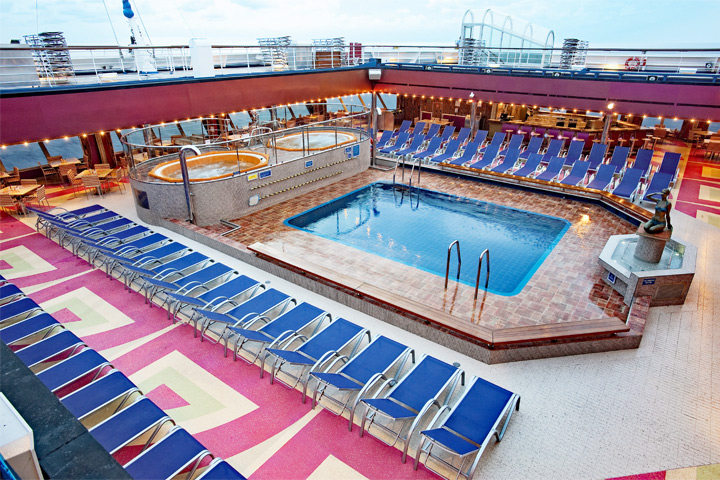
Pool
- Disco/Nightclub
- Theater/Show Lounge
- Outdoor Movies
- Fitness Center
- Educational Programs
- Miniature Golf
- Pool - Outdoor
- Sports Facilities
- Water Slide
- Whirlpool/Jacuzzi
- Art Gallery
- Internet Center
- Library
- Children's Indoor Play Area
- Organized Age Specific Activities
- Teen Center or Disco
- Teen Programs
- Duty-Free Shops/Boutiques
- Elevators
- Safe Deposit Boxes
Activities & Services (available for an extra fee)
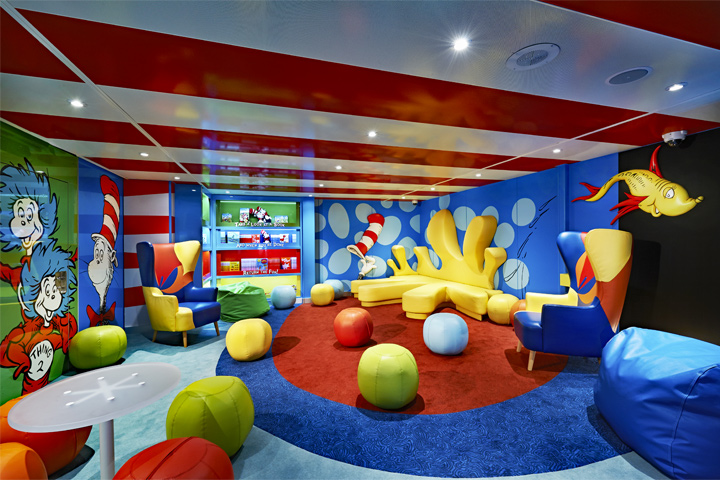
Dr. Seuss Bookville
- Card Room
- Casino
- Game Arcade
- Beauty Salon
- Fitness Classes
- Spa Services/Massage
- Sauna/Steam Room
- Bars/Lounges
- Babysitting
- Conference Center
- Dry Cleaning/ Laundry Service
- Infirmary/Medical Center
- Self-Service Laundromat
- Wedding/Vow Renewal
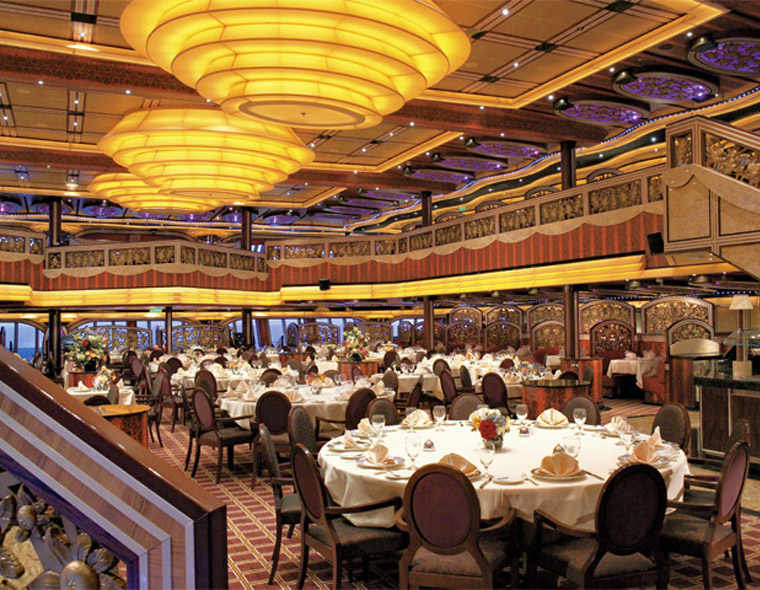
Main Dining Room
Main Dining
Main Dining Room: Carnival's Main Dining Room brings you a full three-course menu in an experience that’s satisfying, but never stuffy. Drop in nightly and enjoy a rotating menu of delectable favorites like steak, roasted duck, scallops, prime rib, and, of course, sinfully delicious desserts.
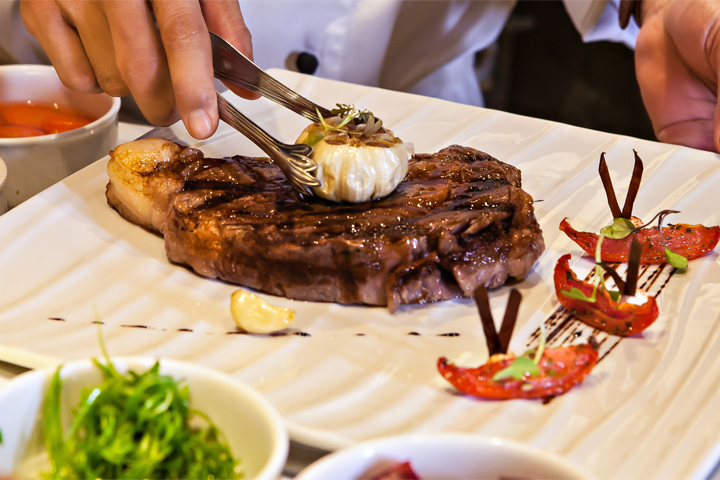
Steakhouse
Specialty Dining
Bonsai Sushi Express: Sometimes you sit and take things slow, and sometimes you gotta roll — there's just so much to do on a Carnival cruise! Cruisers with places to be, fun to get done, meet the new Bonsai Sushi™ Express. Your made to order sushi source at sea features a mouthwatering selection of sushi, sashimi, rolls and more — made to order and packed up to take with you. And don't forget that there's more to Bonsai Sushi Express than just the quickness… getting your roll on the run is an easy way to enjoy it anywhere on the ship. This restaurant is available for an additional cost.
Coffee Bar: Treat yourself to a well-deserved break with a specialty coffee drink or freshly-brewed tea with some delicious homemade pastries. Or, for an even sweeter option, stop by for a milkshake, slice of cake or cookie. This restaurant is available for an additional cost.
Green Eggs and Ham Breakfast: Sit down to a truly fantastical feast at the Green Eggs and Ham Breakfast with The Cat in the Hat and Friends™. Bright colors and patterns decorate your table, which features fun and unique menus. Feast! Feast! Feast! Lose yourself exploring a delicious menu where you'll find "Green Eggs and Ham," brightly colored fruit, gravity-defying pancake stacks, funky french toast, "Moose Juice" 'n' "Goose Juice"… and much more. (Classic breakfast offerings are available as well.) Breakfast is also the perfect time to meet and greet the stars of Dr. Seuss — characters will be around for special photo opportunities and fun interactions, making this a meal to remember. This restaurant is available for an additional cost.
RedFrog Pub: Get into an island state of mind before you even set foot on one. RedFrog Pub is Carnival's laid-back, no-worries, oh-so-lively, Key West-inspired pub. Sample Caribbean fare, dominate at the foosball table, enjoy live music and try the signature private-label brew, ThirstyFrog Red. This restaurant is available for an additional cost.
Seafood Shack: A good seafood dish is quite the catch. However you like yours served — whether it’s on a roll, in a salad or atop a platter — Seafood Shack’s the place to cast your net. Imagine a New England-style seaside spot where you can take it all in, enjoying a great meal complete with a side of ocean view. This restaurant is available for an additional cost.
Steakhouse: The menu features premium cuts of beef cooked to your specifications, as well as a fantastic selection of seafood, entrées, gourmet appetizers and an extensive wine list. Like any destination restaurant, reservations for Steakhouse are highly recommended. Your meal includes an appetizer, salad, entrée, side and dessert. This restaurant is available for an additional cost.
Steakhouse Selections: Whoever said you can’t always get what you want certainly never said it on a Carnival cruise. Odds are that something steakhouse style sounds good — filet mignon, New York Strip, lobster, or surf and turf. Now you can get these signature steakhouse dishes anytime you’re enjoying dinner in the main dining room. This option is available for an additional cost.
The Chef’s Table: Treat your taste buds to a unique culinary event hosted by one of Carnival's master chefs. Your VIP experience begins with cocktails and hors d’oeuvres for a select group of 14, followed by a galley tour. The evening’s highlight is a full-service dinner of amazing appetizers, entrees and desserts not found on the regular menus. Seating is limited, so reserve early at the ship’s Guest Services desk. This restaurant is available for an additional cost.
24-Hour Room Service: There’s a menu of salads, sandwiches and sweet stuff — completely free — during the day, plus hot food options available for a small fee. Late-night menu options (after 10 p.m.) are also available for a small fee.
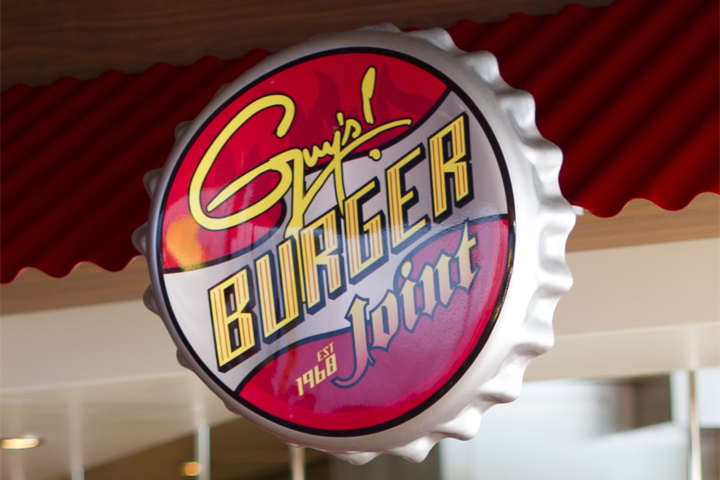
Guy's Burger Joint
Casual Dining
BlueIguana Cantina: The BlueIguana Cantina features freshly made tacos and burritos. Throw homemade tortillas and salsa into the mix, and you have a casual dining experience that will have you coming back for more.
Guy’s Burger Joint: Carnival has teamed up with celebrity chef Guy Fieri to bring all the authentic appeal of a roadside burger shack to Guy's Burger Joint, the cool poolside spot for hot burgers and hand-cut fries. Try a fresh-off-the-grill burger Guy's way, or take it off-road to the toppings bar and truly make it your own.
Lido Marketplace: Featuring an amazing variety of casual dining spots, each just a few flip-flopped steps from the last, Lido Marketplace always has a special something ready to satisfy your latest craving spectacularly. Here Carnival does it with dozens of what-to-eat options... great choices like BBQ, a deli counter, salad bar, an Asian station and a pasta bar... plus one spot where the chef serves up a different surprise daily! At Lido Marketplace, there's tons of indoor and outdoor seating made for gathering around, so you can enjoy your personal faves in your favorite company for lunch or dinner, or even breakfast! Lido's also where you can find soft serve, frozen yogurt and fresh pizza 24 hours a day.
Mongolian Wok: Create your own dish at the Mongolian Wok. First, select your noodles and veggies. Then tell the chef which sauce and meat you want in the wok. Will it be mussels and Szechuan? Beef and Thai barbecue? Chicken and black bean? Come back to Mongolian Wok and try all the combos your heart desires!
Pizza Pirate: Ahoy, matey! Pizza Pirate offers mouth-watering Margherita, Funghi, Prosciutto, Pepperoni or Quattro Formaggi pizza served with a delicious Caesar salad.
Seaday Brunch: At Seaday Brunch, you can sleep in and still enjoy breakfast favorites, while early risers get a head start on lunch. You’ll enjoy huevos rancheros, special French toast, loaded mac-n-cheese and more ways to cook eggs than you may have thought possible.
Swirls: Swirls ice cream entices with sweet frozen treats around the clock! Choose from chocolate, vanilla or strawberry. Open on Lido deck 24/7, frozen yogurt and soft-serve ice cream is a great way to beat the heat all day, or the perfect nightcap after a long evening of fun.
The Carnival Deli: Craving a little taste from the old neighborhood? Enjoy old-time favorites like a hot pastrami on rye, a grilled Reuben or roasted turkey breast on a country roll. Sandwiches and wraps are always hand-carved, and served fresh with coleslaw or relish and a kosher dill pickle.
Interior staterooms include a wide array of amenities for your whole family to enjoy.
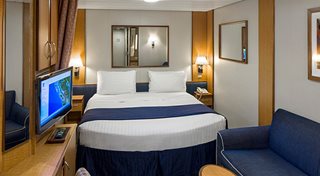
Category: 4V
- Our most budget-friendly option
- A cozy and comfortable retreat
- Perfect for long naps after an adventure-filled day
Beds
- One Royal King bed (can convert into two twin-size beds)
- One single sofa bed in staterooms with up to 3 or 4 guests
- One fold-down Pullman bed in staterooms with up to 3 or 4 guests
Size
- Stateroom: 170 sq. ft.

Category: 3V
- Our most budget-friendly option
- A cozy and comfortable retreat
- Perfect for long naps after an adventure-filled day
Beds
- One Royal King bed (can convert into two twin-size beds)
- One single sofa bed in staterooms with up to 3 or 4 guests
- One fold-down Pullman bed in staterooms with up to 3 or 4 guests
Size
- Stateroom: 170 sq. ft.

Category: 2V
- Our most budget-friendly option
- A cozy and comfortable retreat
- Perfect for long naps after an adventure-filled day
Beds
- One Royal King bed (can convert into two twin-size beds)
- One single sofa bed in staterooms with up to 3 or 4 guests
- One fold-down Pullman bed in staterooms with up to 3 or 4 guests
Size
- Stateroom: 170 sq. ft.

Category: 1V
- Our most budget-friendly option
- A cozy and comfortable retreat
- Perfect for long naps after an adventure-filled day
Beds
- One Royal King bed (can convert into two twin-size beds)
- One single sofa bed in staterooms with up to 3 or 4 guests
- One fold-down Pullman bed in staterooms with up to 3 or 4 guests
Size
- Stateroom: 170 sq. ft.
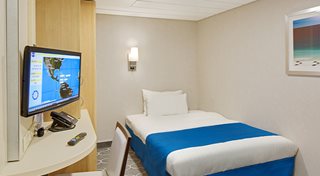
Category: 2W
- Sized perfectly for solo adventurers
- One of our most budget-friendly options
- Same amenities as all other staterooms
Beds
- One full-size bed
Size
- Stateroom: 108 sq. ft.

Category: ZI
This category can be booked for a special rate, guaranteed to you. Please note that the category is not associated at the time of booking with a specific stateroom, deck, bedding configuration or other particular settings. The assignment of an actual cabin will be performed during your check-in. The cabin can be anywhere on the ship.
Spectacular sights and amazing views from the comfort of your stateroom.
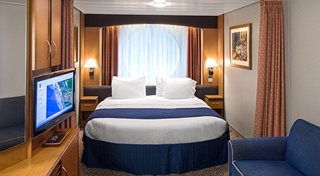
Category: 1N
- Budget-friendly with a view of the ocean
- Your very own in-stateroom window
- Great for families with small children
Beds
- One Royal King bed (can convert into two twin-size beds)
- One double sofa bed in staterooms with up to 3 or 4 guests
Size
- Stateroom: 170 sq. ft.

Category: 2N
- Budget-friendly with a view of the ocean
- Your very own in-stateroom window
- Great for families with small children
Beds
- One Royal King bed (can convert into two twin-size beds)
- One double sofa bed in staterooms with up to 3 or 4 guests
Size
- Stateroom: 170 sq. ft.

Category: 3N
- Budget-friendly with a view of the ocean
- Your very own in-stateroom window
- Great for families with small children
Beds
- One Royal King bed (can convert into two twin-size beds)
- One double sofa bed in staterooms with up to 3 or 4 guests
Size
- Stateroom: 170 sq. ft.

Category: 4N
- Budget-friendly with a view of the ocean
- Your very own in-stateroom window
- Great for families with small children
Beds
- One Royal King bed (can convert into two twin-size beds)
- One double sofa bed in staterooms with up to 3 or 4 guests
Size
- Stateroom: 170 sq. ft.

Category: CO
- Connects to the room next door
- Get "double" the space by booking both
- Great for families
Beds
- Royal King Bed (can convert into two twin-size beds)
Size
- Stateroom: 170 sq. ft.

Category: 4M
- Extra square footage at a great value
- Perfect if you need that little extra space
- Your very own in-stateroom window
Beds
- One Royal King Bed (can convert into two twin-size beds)
Size
- Stateroom: 170 sq. ft.
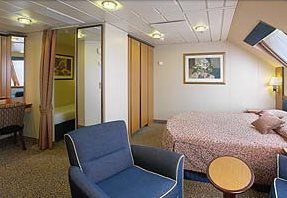
Category: 1K
- Even more square footage
- Dedicated bunk bed area
- Perfect for families or groups
Beds
- Two Royal King beds (each can convert into two twin-size beds)
- One twin-size bed
Size
- Stateroom: 265 sq. ft.

Category: YO
This category can be booked for a special rate, guaranteed to you. Please note that the category is not associated at the time of booking with a specific stateroom, deck, bedding configuration or other particular settings. The assignment of an actual cabin will be performed during your check-in. The cabin can be anywhere on the ship.
Enjoy the ambiance of our neighborhood balcony staterooms that overlook the Central Park and Boardwalk neighborhoods or take in breathtaking views from your Ocean View balcony stateroom.
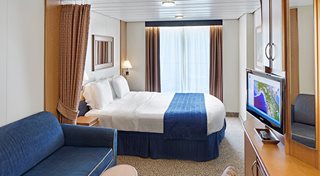
Category: 1B
- Extra square footage at a great value
- Perfect if you need that little extra space
- Private balcony with chairs for those pristine ocean views
Beds
- One Royal King bed (can convert into two twin-size beds)
- One single sofa bed in staterooms with up to 3 guests
- One double sofa bed in staterooms with up to 4 or 5 guests
Size
- Stateroom: 204 sq. ft.
- Balcony: 41 sq. ft.

Category: 2B
- Extra square footage at a great value
- Perfect if you need that little extra space
- Private balcony with chairs for those pristine ocean views
Beds
- One Royal King bed (can convert into two twin-size beds)
- One single sofa bed in staterooms with up to 3 guests
- One double sofa bed in staterooms with up to 4 or 5 guests
Size
- Stateroom: 204 sq. ft.
- Balcony: 41 sq. ft.

Category: 3B
- Extra square footage at a great value
- Perfect if you need that little extra space
- Private balcony with chairs for those pristine ocean views
Beds
- One Royal King bed (can convert into two twin-size beds)
- One single sofa bed in staterooms with up to 3 guests
- One double sofa bed in staterooms with up to 4 or 5 guests
Size
- Stateroom: 204 sq. ft.
- Balcony: 41 sq. ft.

Category: 4B
- Extra square footage at a great value
- Perfect if you need that little extra space
- Private balcony with chairs for those pristine ocean views
Beds
- One Royal King bed (can convert into two twin-size beds)
- One single sofa bed in staterooms with up to 3 guests
- One double sofa bed in staterooms with up to 4 or 5 guests
Size
- Stateroom: 204 sq. ft.
- Balcony: 41 sq. ft.
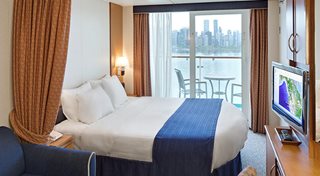
Category: CB
- Balcony stateroom that connects to the room next door
- Get "double" the space by booking both
- Great for families
Beds
- Royal King Bed (can convert into two twin-size beds)
Size
- Stateroom: 179 sq. ft.
- Balcony: 41 sq. ft.

Category: 1D
- Our standard balcony stateroom
- Pristine views of the ocean
- Private balcony with chairs
Beds
- One Royal King bed (can convert into two twin-size beds)
- One single sofa bed in staterooms with up to 3 guests
- One double sofa bed in staterooms with up to 4 guests
Size
- Stateroom: 179 sq. ft.
- Balcony: 20 - 41 sq. ft.

Category: 2D
- Our standard balcony stateroom
- Pristine views of the ocean
- Private balcony with chairs
Beds
- One Royal King bed (can convert into two twin-size beds)
- One single sofa bed in staterooms with up to 3 guests
- One double sofa bed in staterooms with up to 4 guests
Size
- Stateroom: 179 sq. ft.
- Balcony: 20 - 41 sq. ft.

Category: 3D
- Our standard balcony stateroom
- Pristine views of the ocean
- Private balcony with chairs
Beds
- One Royal King bed (can convert into two twin-size beds)
- One single sofa bed in staterooms with up to 3 guests
- One double sofa bed in staterooms with up to 4 guests
Size
- Stateroom: 179 sq. ft.
- Balcony: 20 - 41 sq. ft.

Category: 4D
- Our standard balcony stateroom
- Pristine views of the ocean
- Private balcony with chairs
Beds
- One Royal King bed (can convert into two twin-size beds)
- One single sofa bed in staterooms with up to 3 guests
- One double sofa bed in staterooms with up to 4 guests
Size
- Stateroom: 179 sq. ft.
- Balcony: 20 - 41 sq. ft.

Category: 5D
- Our standard balcony stateroom
- Pristine views of the ocean
- Private balcony with chairs
Beds
- One Royal King bed (can convert into two twin-size beds)
- One single sofa bed in staterooms with up to 3 guests
- One double sofa bed in staterooms with up to 4 guests
Size
- Stateroom: 179 sq. ft.
- Balcony: 20 - 41 sq. ft.

Category: XB
This category can be booked for a special rate, guaranteed to you. Please note that the category is not associated at the time of booking with a specific stateroom, deck, bedding configuration or other particular settings. The assignment of an actual cabin will be performed during your check-in. The cabin can be anywhere on the ship.
Exclusive experiences, inclusive amenities, luxury accommodations and more.
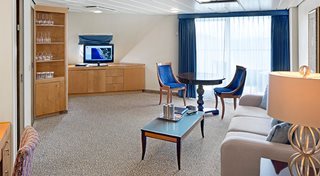
Category: OT
- High-occupancy two-bedroom and two-bathroom suite
- Perfect for groups or families
Beds
- Two Royal King beds (each can convert into two twin-size beds)
- One double sofa bed
Size
- Stateroom: 584 sq. ft.
- Balcony: 151 sq. ft.
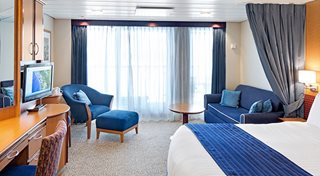
Category: J3
- Our standard suite for luxury
- Private balcony with two chairs
- Live the suite life on a budget
Beds
- One Royal King bed (can convert into two twin-size beds)
- One double sofa bed
Size
- Stateroom: 299 sq. ft.
- Balcony: 66 sq. ft.
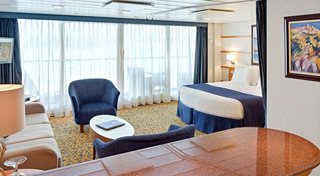
Category: GS
- Ample space, including a living room and full bathroom with a tub
- Private balcony with seating
- "Grandest" suite in the fleet
Beds
- One Royal King bed (can convert into two twin-size beds)
- One double sofa bed
Size
- Stateroom: 385 sq. ft.
- Balcony: 106 sq. ft.
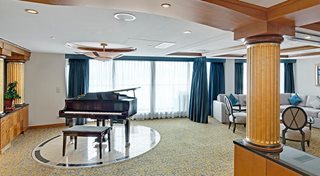
Category: RS
- Extra-large suite with expansive square footage
- Panoramic views with a large balcony
- Living area with baby grand piano
Beds
- One King-size bed
- One double sofa bed
Size
- Stateroom: 952 sq. ft.
- Balcony: 172 sq. ft.
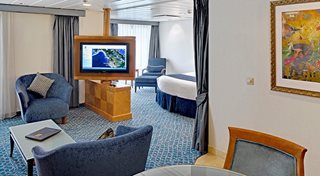
Category: OS
- Larger and more luxurious than our one bedroom Grand Suites
- Put the extra square footage to use as you kick back and relax
Beds
- One Royal King bed (can convert into two twin-size beds)
- One double sofa bed
Size
- Stateroom: 532 sq. ft.
- Balcony: 57 sq. ft.

Category: WS
This category can be booked for a special rate, guaranteed to you. Please note that the category is not associated at the time of booking with a specific stateroom, deck, bedding configuration or other particular settings. The assignment of an actual cabin will be performed during your check-in. The cabin can be anywhere on the ship.
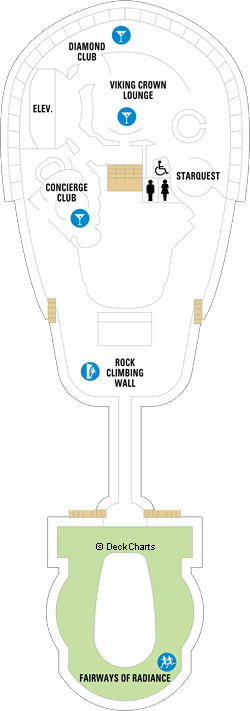
| Symbol | Description |
|---|---|
 | Stateroom for occupancy 5 and up |
 | Stateroom for occupancy up to 4 |
 | Accessible stateroom |
 | Stateroom has an obstructed view |
 | Stateroom for occupancy up to 3 |
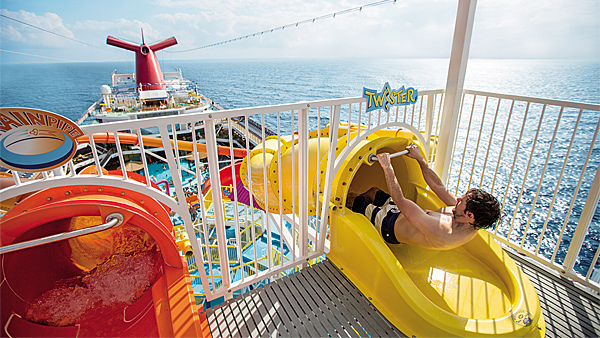
- Ship Name: Carnival Freedom
- Year Built: 2006
- Year Refurbished: 2014
- Year Entered Present Fleet: 2007
- Ship Class: Conquest Class
- Maximum Capacity: 3,754
- Number of Passenger Decks: 13
- Number of Crew: 1,180
- Officers' Nationality: Italian
- Ocean-View without Balcony: 340
- Ocean-View with Balcony: 521
- Total Inside Staterooms: 575
- Tonnage (GRT): 110,000
- Capacity Based on Double Occupancy: 2,980
- Country of Registry: Panama
- Total Staterooms: 1,490
- Suites with Balcony: 44
- Crew/Hotel Staff Nationality: International
Costco Member Reviews

Terms & Conditions
*Price shown is per person based on double occupancy and is valid for select stateroom categories only. Click on the Terms & Conditions link below for details.
†One Digital Costco Shop Card per room/stateroom, per stay. The exact amount of the Digital Costco Shop Card will be calculated during the booking process. The Digital Costco Shop Card promotion is nontransferable and may not be combined with any other promotion. A Digital Costco Shop Card will arrive by email approximately 10 days after the start of your cruise. Click on the Terms & Conditions link below for additional information.
Ship's registry: Panama
Digital Costco Shop Card
This booking includes a Digital Costco Shop Card which will arrive by email one to two weeks after you return from your vacation. The Digital Costco Shop Card is a convenient payment option in our warehouses and on Costco.com.

